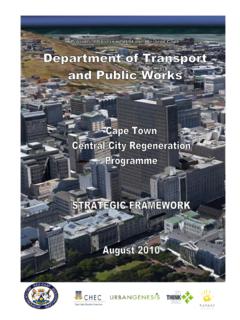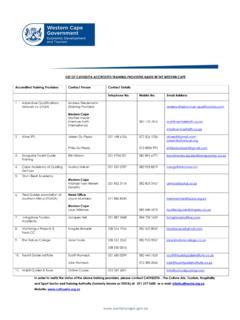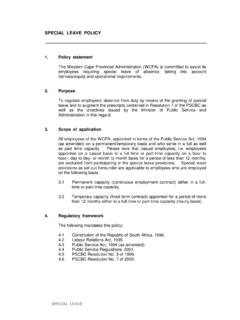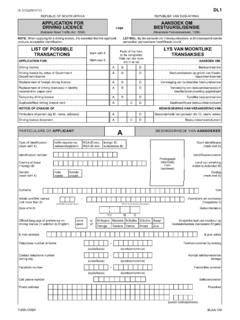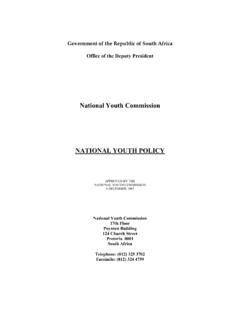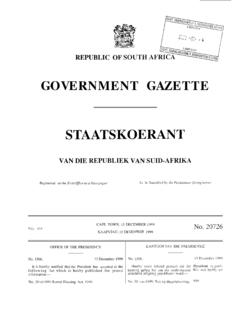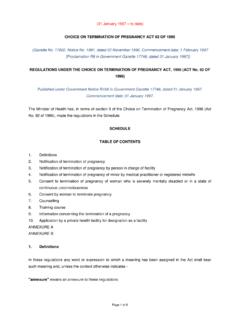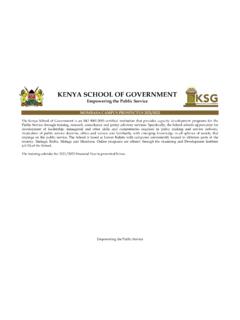Transcription of Introduction: A policy framework for disaster risk ...
1 1 South Africa s disaster risk management contextSouth Africa faces increasing levels of disaster risk. It is exposed to a wide range of weatherhazards, including drought, cyclones and severe storms that can trigger widespread hardshipand devastation. In addition, South Africa s extensive coastline and proximity to shippingroutes present numerous marine and coastal threats. Similarly, our shared borders with sixsouthern African neighbours present both natural and human-induced cross-boundary risks,as well as humanitarian assistance obligations in times of addition to these natural and human-induced threats and despite ongoing progress toextend essential services to poor urban and rural communities, large numbers of people livein conditions of chronic disaster vulnerability in underserved.
2 Ecologically fragile or mar-ginal areas where they face recurrent natural and other threats that range from drought torepeated informal settlement floods in Cape Town s historically disadvantaged Cape Flats in June 1994 profiled theurgency for legislative reform in the field of disaster risk management, stimulating a consul-tative process which resulted in Green and White Papers on disaster Management. Theseimportant discussion and policy documents afforded opportunity for consultation with mul-tiple stakeholder groups and provided the platform for development of draft legislation in2000 that was consistent with emerging international trends in disaster risk sustained, committed and concerted efforts with regard to disaster risk managementreform by the government and a wide range of stakeholders were reflected in the promulga-tion of the disaster Management Act, 2002 (Act No.)
3 57 of 2002) on 15 January 2003. The Act provides for: an integrated and co-ordinated disaster risk management policy that focuses on preventingor reducing the risk of disasters, mitigating the severity of disasters, preparedness, rapidand effective response to disasters, and post- disaster recovery the establishment of national, provincial and municipal disaster management centres disaster risk management volunteers matters relating to these Act recognises the wide-ranging opportunities in South Africa to avoid and reduce dis-aster losses through the concerted energies and efforts of all spheres of government, civilsociety and the private sector.
4 However, it also acknowledges the crucial need for uniformityin the approach taken by such a diversity of role players and partners. The national disaster management framework is the legal instrument specified by the Act toaddress such needs for consistency across multiple interest groups, by providing a coherent,transparent and inclusive policy on disaster management appropriate for the Republic as awhole (section 7(1)).Introduction: A policy framework for disaster risk management in South Africa2In this context, the national disaster management framework recognises a diversity of risksand disasters that occur in southern Africa, and gives priority to developmental measures thatreduce the vulnerability of disaster -prone areas, communities and households.
5 Also, in keep-ing with international best practice, the national disaster management framework placesexplicit emphasis on the disaster risk reduction concepts of disaster prevention and mitiga-tion as the core principles to guide disaster risk management in South national disaster management framework also informs the subsequent development ofprovincial and municipal disaster management frameworks and plans, which are required toguide action in all spheres of of the national disaster management frameworkdocumentThe national disaster management framework comprises four key performance areas (KPAs)and three supportive enablers required to achieve the objectives set out in the KPAs.
6 TheKPAs and enablers are informed by specified objectives and, as required by the Act, key per-formance indicators (KPIs) to guide and monitor progress. In addition, each KPAand enablerconcludes with a list of guidelines that will be disseminated by the NDMC to support theimplementation of the framework in all three spheres of government. Key performance area 1 focuses on establishing the necessary institutional arrangements forimplementing disaster risk management within the national, provincial and municipalspheres of government. It specifically addresses the application of the principle of co-opera-tive governance for the purposes of disaster risk management.
7 It also emphasises theinvolvement of all stakeholders in strengthening the capabilities of national, provincial andmunicipal organs of state to reduce the likelihood and severity of disasters. KPA 1 describesprocesses and mechanisms for establishing co-operative arrangements with international roleplayers and countries within southern Africa. Key performance area 2 addresses the need for disaster risk assessment and monitoring to setpriorities, guide risk reduction action and monitor the effectiveness of our efforts. AlthoughDisaster risk managementThe term disaster risk management refers to integrated multisectoral and multidisciplinary administrative, organi-sational and operational planning processes and capacities aimed at lessening the impacts of natural hazards andrelated environmental, technological and biological disasters.
8 This broad definition encompasses the definition of disaster management as it is used in the disaster Management Act, 2002 (Act No. 57 of 2002). However,where appropriate, the more updated term disaster risk management is preferred in this framework because it isconsistent with the use of the term risk reductionSimilarly, the preferred term disaster risk reduction is used throughout this framework . It refers to all the elements that are necessary to minimise vulnerabilities and disaster risks throughout a society. It includes the core risk reduction principles of prevention, mitigation and note on terminology3 South Africa faces many different types of risk, disaster risk specifically refers to the likeli-hood of harm or loss due to the action of hazards or other external threats on vulnerablestructures, services, areas, communities and households.
9 KPA2 outlines the requirements forimplementing disaster risk assessment and monitoring by organs of state within all spheresof performance area 3 introduces disaster risk management planning and implementationto inform developmentally-oriented approaches, plans, programmes and projects that reducedisaster risks. KPA 3 addresses requirements for the alignment of disaster managementframeworks and planning within all spheres of government. It also gives particular attentionto the planning for and integration of the core risk reduction principles of prevention and mit-igation into ongoing programmes and performance area 4 presents implementing priorities concerned with disaster responseand recovery and rehabilitation.
10 KPA 4 addresses requirements in the Act for an integratedand co-ordinated policy that focuses on rapid and effective response to disasters and post- disaster recovery. When a significant event or disaster occurs or is threatening to occur, it isimperative that there must be no confusion as to roles and responsibilities and the necessaryprocedures to be followed. KPA 4 describes measures to ensure effective disaster response,recovery and rehabilitation 1 focuses on priorities related to the establishment of an integrated and comprehen-sive information management and communication system for disaster risk specifically, it addresses the information and communication requirements of eachKPA and Enablers 2 and 3 and emphasises the need to establish integrated communicationlinks with all disaster risk management role players in national, provincial and municipalspheres of 2 addresses disaster risk management priorities in education, training, public aware-ness and research.

